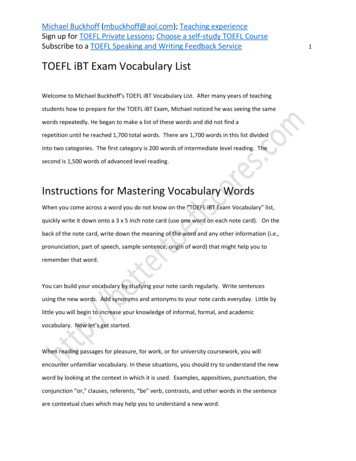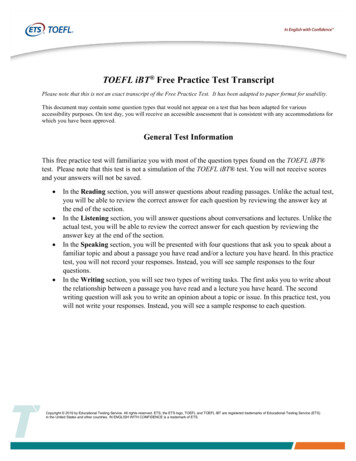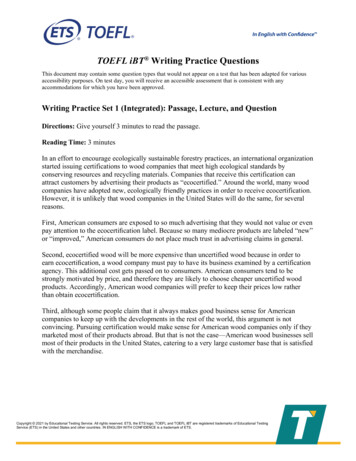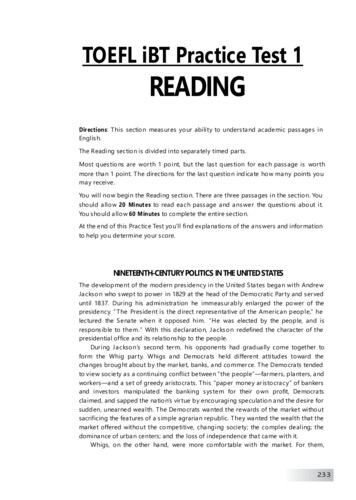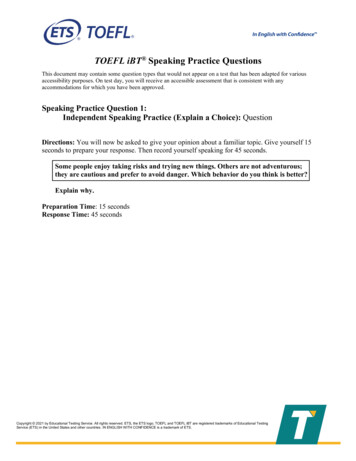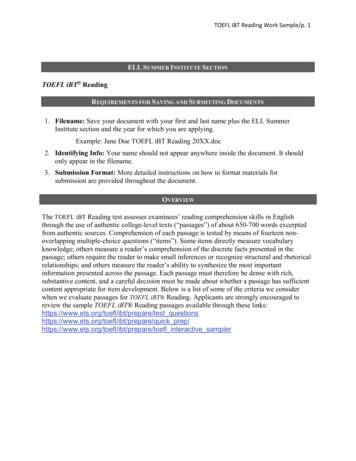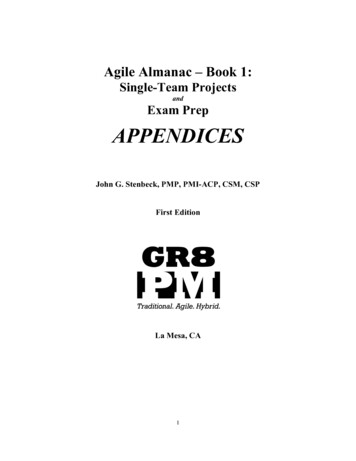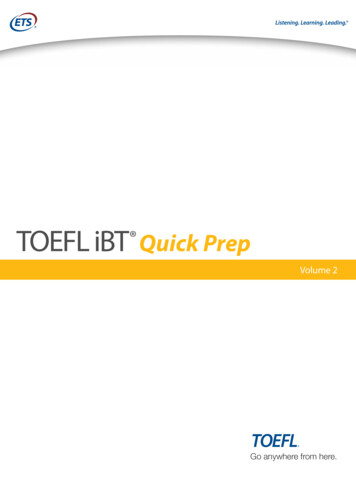
Transcription
TOEFL iBT Quick PrepVolume 2Go anywhere from here.
TOEFL iBT Quick PrepINTRODUCTIONIntroductionAbout the TOEFL iBT testThe TOEFL iBT test measures your ability to use and understand the English language as it is read, heard, spoken,and written in the university classroom. As the most accepted English-language test in the world, more than 8,000universities, agencies, and other institutions in more than 130 countries accept TOEFL scores as part of theiradmissions criteria.In order for the TOEFL iBT test to measure how well you read, listen, speak, and write in English, and how well youuse these skills together, you will be asked to integrate these skills. For example, you may read a passage or listento a lecture, and then write or speak about what you learned.using toeFL ibt Quick PrePTOEFL iBT Quick Prep can help you prepare for the TOEFL iBT test. All the questions in this Quick Prep book arereal TOEFL iBT questions given to examinees at worldwide test administrations, but some questions are presenteddifferently than on the real test.Quick Prep includes questions from all four sections of the TOEFL iBT test: Reading, Listening, Speaking, andWriting.In Quick Prep, the Listening, Speaking, and Writing sections include written transcripts of the audio portions of thetest. If you have access to people with good English pronunciation, ask them to read the transcripts aloud to you.Listening to the transcripts is better practice than reading them to yourself. If someone reads the transcripts toyou, make sure you see the pictures.As in the real test, you may take notes while you listen, and you may use your notes to help you answer thequestions.For More inForMAtionFor complete information about what to expect on the test, how to prepare, and how to register, visitwww.toelgoanywhere.org.Copyright 2011 by Educational Testing Service. All rights reserved. ETS, the ETS logo, LISTENING. LEARNING. LEADING., TOEFL andTOEFL iBT are registered trademarks of Educational Testing Service (ETS) in the United States and other countries. TOEFL-QP-09102
TOEFL iBT Quick PrepReading SectionThis section measures your ability to understand academic passages in English. You can skip questions and goback to them later as long as there is time remaining.Now begin the Reading section.
TOEFL iBT Quick PrepReaDINg PRaCTICe SeT 1Reading Practice Set 1: Passage and QuestionsDirections: Read the passage. Then answer the questions. Give yourself 20 minutes to complete this practice set.extinction oF the DinosAursParagraph1 Paleontologists have argued for a long time that the demise of the dinosaurs wascaused by climatic alterations associated with slow changes in the positions ofcontinents and seas resulting from plate tectonics. Off and on throughout theCretaceous (the last period of the Mesozoic era, during which dinosaurs lourished),large shallow seas covered extensive areas of the continents. Data from diversesources, including geochemical evidence preserved in sealoor sediments, indicatethat the Late Cretaceous climate was milder than today’s. The days were not too hot,nor the nights too cold. The summers were not too warm, nor the winters too frigid.The shallow seas on the continents probably buffered the temperature of the nearbyair, keeping it relatively constant.2At the end of the Cretaceous, the geological record shows that these seawaysretreated from the continents back into the major ocean basins. No one knowswhy. Over a period of about 100,000 years, while the seas pulled back, climatesaround the world became dramatically more extreme: warmer days, cooler nights;hotter summers, colder winters. Perhaps dinosaurs could not tolerate these extremetemperature changes and became extinct.3If true, though, why did cold-blooded animals such as snakes, lizards, turtles, andcrocodiles survive the freezing winters and torrid summers? These animals are at themercy of the climate to maintain a livable body temperature. It’s hard to understandwhy they would not be affected, whereas dinosaurs were left too crippled to cope,especially if, as some scientists believe, dinosaurs were warm-blooded. Criticsalso point out that the shallow seaways had retreated from and advanced on thecontinents numerous times during the Mesozoic, so why did the dinosaurs survivethe climatic changes associated with the earlier luctuations but not with this one?Although initially appealing, the hypothesis of a simple climatic change related to sealevels is insuficient to explain all the data.4
TOEFL iBT Quick PrepParagraphReaDINg PRaCTICe SeT 14Dissatisfaction with conventional explanations for dinosaur extinctions led to asurprising observation that, in turn, has suggested a new hypothesis. Many plantsand animals disappear abruptly from the fossil record as one moves from layersof rock documenting the end of the Cretaceous up into rocks representing thebeginning of the Cenozoic (the era after the Mesozoic). Between the last layer ofCretaceous rock and the irst layer of Cenozoic rock, there is often a thin layer ofclay. Scientists felt that they could get an idea of how long the extinctions took bydetermining how long it took to deposit this one centimeter of clay and they thoughtthey could determine the time it took to deposit the clay by determining the amountof the element iridium (Ir) it contained.5Ir has not been common at Earth’s surface since the very beginning of theplanet’s history. Because it usually exists in a metallic state, it was preferentiallyincorporated in Earth’s core as the planet cooled and consolidated. Ir is found in highconcentrations in some meteorites, in which the solar system’s original chemicalcomposition is preserved. Even today, microscopic meteorites continually bombardEarth, falling on both land and sea. By measuring how many of these meteorites fallto Earth over a given period of time, scientists can estimate how long it might havetaken to deposit the observed amount of Ir in the boundary clay. These calculationssuggest that a period of about one million years would have been required. However,other reliable evidence suggests that the deposition of the boundary clay could nothave taken one million years. So the unusually high concentration of Ir seems torequire a special explanation.6In view of these facts, scientists hypothesized that a single large asteroid, about 10to 15 kilometers across, collided with Earth, and the resulting fallout created theboundary clay. Their calculations show that the impact kicked up a dust cloud thatcut off sunlight for several months, inhibiting photosynthesis in plants; decreasedsurface temperatures on continents to below freezing; caused extreme episodesof acid rain; and signiicantly raised long-term global temperatures through thegreenhouse effect. This disruption of food chain and climate would have eradicatedthe dinosaurs and other organisms in less than ifty years.Directions: Now answer the questions.1. according to paragraph 1, which of the following is true of the Late Cretaceous climate?(A) Summers were very warm and winters were very cold.(B) Shallow seas on the continents caused frequent temperature changes.(C) The climate was very similar to today’s climate.(D) The climate did not change dramatically from season to season.5
TOEFL iBT Quick PrepReaDINg PRaCTICe SeT 12. Which of the following reasons is suggested in paragraph 2 for the extinction of the dinosaurs?(A) Changes in the lengths of the days and nights during the Late Cretaceous period(B) Droughts caused by the movement of seaways back into the oceans(C) The change from mild to severe climates during the Late Cretaceous period(D) An extreme decrease in the average yearly temperature over 10,000 years3. Why does the author mention the survival of “snakes, lizards, turtles, and crocodiles” in paragraph 3?(A) To argue that dinosaurs may have become extinct because they were not cold-blooded animals(B) To question the adequacy of the hypothesis that climatic change related to sea levels caused theextinction of the dinosaurs(C) To present examples of animals that could maintain a livable body temperature more easily thandinosaurs(D) To support a hypothesis that these animals were not as sensitive to climate changes in theCretaceous period as they are today4. The word “cope” in the passage is closest in meaning to(A) adapt(B) move(C) continue(D) compete5. according to paragraph 3, which of the following is true of changes in climate before the Cretaceousperiod and the effect of these changes on dinosaurs?(A) Climate changes associated with the movement of seaways before the Cretaceous period did notcause dinosaurs to become extinct.(B) Changes in climate before the Cretaceous period caused severe luctuation in sea level, resultingin the extinction of the dinosaurs.(C) Frequent changes in climate before the Cretaceous period made dinosaurs better able tomaintain a livable body temperature.(D) Before the Cretaceous period there were few changes in climate, and dinosaurs lourished.6. The word “luctuations” in the passage is closest in meaning to(A) extremes(B) retreats(C) periods(D) variations6
TOEFL iBT Quick PrepReaDINg PRaCTICe SeT 17. Which of the sentences below best expresses the essential information in the highlighted sentencein paragraph 4? Incorrect choices change the meaning in important ways or leave out essentialinformation.(A) The fossil record suggests that there was an abrupt extinction of many plants and animals at theend of the Mesozoic era.(B) Few fossils of the Mesozoic era have survived in the rocks that mark the end of the Cretaceous.(C) Fossils from the Cretaceous period of the Mesozoic up to the beginning of the Cenozoic era havebeen removed from the layers of rock that surrounded them.(D) Plants and animals from the Mesozoic era were unable to survive in the Cenozoic era.8. In paragraph 4, all the following questions are answered eXCePT:(A) Why is there a layer of clay between the rocks of the Cretaceous and Cenozoic?(B) Why were scientists interested in determining how long it took to deposit the layer of clay at theend of the Cretaceous?(C) What was the effect of the surprising observation scientists made?(D) Why did scientists want more information about the dinosaur extinctions at the end of theCretaceous?9. The word “bombard” in the passage is closest in meaning to(A) approach(B) strike(C) pass(D) circle10. Paragraph 5 implies that a special explanation of the Ir in the boundary clay is needed because(A) the Ir in microscopic meteorites reaching Earth during the Cretaceous period would have beenincorporated into Earth’s core(B) the Ir in the boundary clay was deposited much more than a million years ago(C) the concentration of Ir in the boundary clay is higher than in microscopic meteorites(D) the amount of Ir in the boundary clay is too great to have come from microscopic meteoritesduring the time the boundary clay was deposited11. The word “disruption” in the passage is closest in meaning to(A) exhaustion(B) disturbance(C) modiication(D) disappearance12. Paragraph 6 mentions all of the following effects of the hypothesized asteroid collision eXCePT(A) a large dust cloud that blocked sunlight(B) an immediate drop in the surface temperatures of the continents(C) an extreme decrease in rainfall on the continents(D) a long-term increase in global temperatures7
TOEFL iBT Quick PrepReaDINg PRaCTICe SeT 113. In paragraph 5 of the passage, there is a missing sentence. The paragraph is repeated below andshows four letters (a, B, C, and D) that indicate where the following sentence could be added.Consequently, the idea that the Ir in the boundary clay came from microscopic meteorites cannotbe accepted.Where would the sentence best it?Ir has not been common at Earth’s surface since the very beginning of the planet’s history. Because itusually exists in a metallic state, it was preferentially incorporated in Earth’s core as the planet cooled andconsolidated. Ir is found in high concentrations in some meteorites, in which the solar system’s originalchemical composition is preserved. Even today, microscopic meteorites continually bombard Earth, fallingon both land and sea. By measuring how many of these meteorites fall to Earth over a given period oftime, scientists can estimate how long it might have taken to deposit the observed amount of Ir in theboundary clay. (a) These calculations suggest that a period of about one million years would have beenrequired. (B) However, other reliable evidence suggests that the deposition of the boundary clay couldnot have taken one million years. (C) So the unusually high concentration of Ir seems to require a specialexplanation. (D)(A) Option A(B) Option B(C) Option C(D) Option D14. Directions: an introductory sentence for a brief summary of the passage is provided below.Complete the summary by selecting the THRee answer choices that express the most importantideas in the passage. Some sentences do not belong in the summary because they express ideasthat are not presented in the passage or are minor ideas in the passage. This question is worth 2points.Write your answer choices in the spaces where they belong. You can either write the letter of your answerchoice or you can copy the sentence.For a long time scientists have argued that the extinction of the dinosaurs wasrelated to climate change. 8
TOEFL iBT Quick PrepReaDINg PRaCTICe SeT 1answer Choices(A) Extreme changes in daily and seasonal climates preceded the retreat of the seas back into the majorocean basins.(B) A simple climate change does not explain some important data related to the extinction of thedinosaurs at the end of the Cretaceous.(C) The retreat of the seaways at the end of the Cretaceous has not been fully explained.(D) The abruptness of extinctions at the end of the Cretaceous and the high concentration of Ir found inclay deposited at that time have fueled the development of a new hypothesi
TOEFL iBT Quick Prep 2 Introduction About the TOEFL iBT test The TOEFL iBT test measures your ability to use and understand the English language as it is read, heard, spoken, and written in the university classroom. As the most accepted English-language test in the world, more than 8,

